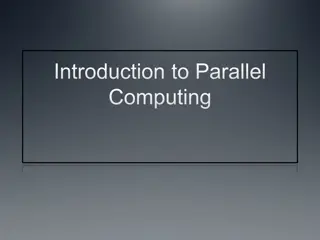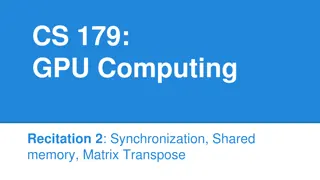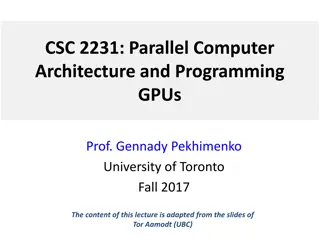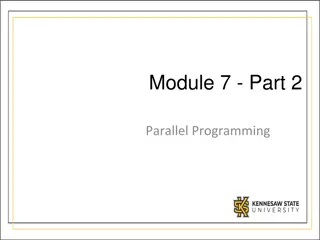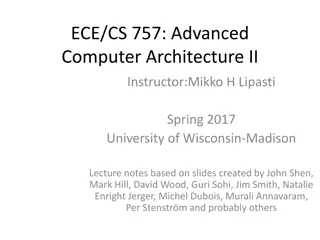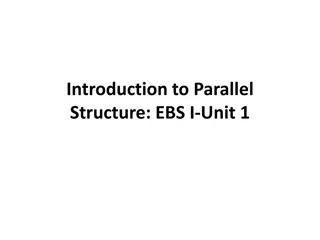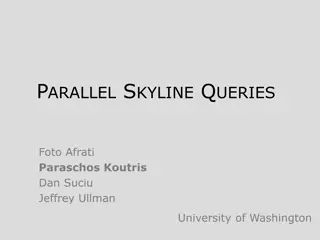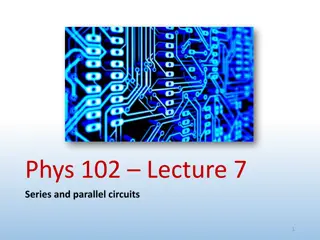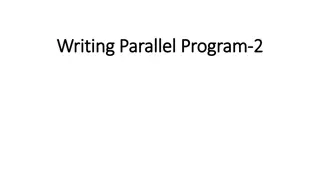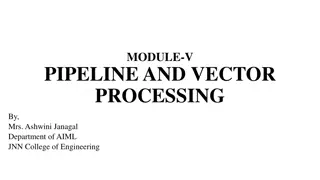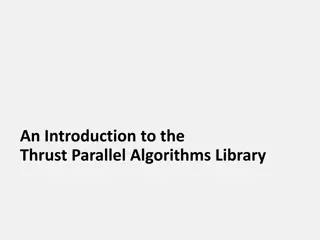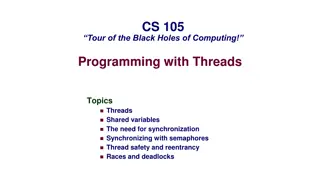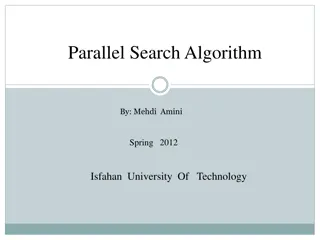Introduction to Parallel Computing Concepts
Exploring the concepts of threads, pipelining, and dependence in parallel computing. Discussions on why multiple threads are beneficial, pipelined instructions, and the challenges of dependencies in executing instructions sequentially. Delve into Simultaneous Multithreading (SMT) and its advantages in optimizing core utilization for executing multiple threads efficiently.
Uploaded on Oct 05, 2024 | 0 Views
Download Presentation

Please find below an Image/Link to download the presentation.
The content on the website is provided AS IS for your information and personal use only. It may not be sold, licensed, or shared on other websites without obtaining consent from the author. Download presentation by click this link. If you encounter any issues during the download, it is possible that the publisher has removed the file from their server.
E N D
Presentation Transcript
EE 193: Parallel Computing Fall 2017 Tufts University Instructor: Joel Grodstein joel.grodstein@tufts.edu Simultaneous Multithreading (SMT) 1
Threads We've talked a lot about threads. In a 16-core system, why would you want to have >1 thread? If you have <16 threads, some of the cores will just be sitting around idle. Why would you ever want more than 16 threads? Perhaps you have 100 users on a 16-core machine, and the O/S rotates them around for fairness Today we'll talk about another reason EE 193 Joel Grodstein 2
More pipelining and stalls Consider a random assembly program load r2=mem[r1] add r5=r3+r2 add r8=r6+r7 The architecture says that instructions are executed in order. The 2nd instruction uses the r2 written by the first instruction EE194/Comp140 Mark Hempstead 3
Pipelined instructions Instruction load r2=mem[r1] fetch Cycle 1 Cycle 2Cycle 3Cycle 4Cycle 5Cycle 6Cycle 7Cycle 8 read R1 execute nothing cache fetch read r3,r2 r3,r2 fetch read r6,r7 fetch access write r2 add r5=r3+r2 add load/st nothing add r6,r7 read r9,r10 write r5 add r8=r6+r7 load/st nothing execute nothing write r8 store mem[r9]=r10 store write nothing Pipelining cheats! It launches instructions before the previous ones finish. Hazards occur when one computation uses the results of another it exposes our sleight of hand EE 193 Joel Grodstein 4
Dependence Pipelining works best when instructions don't use results from just-previous instruction But instructions in a thread tend to be working together on a common mission; this isn't good Each thread has its own register file, by definition They only interact via shared memory or messages One thread cannot read a register that another thread wrote Idea: what if we have one core execute many threads? Does that sound at all clever or useful? EE 193 Joel Grodstein 5
Your pipeline, on SMT Instruction load r2=mem[r1]0 ThreadCycle 1Cycle 2Cycle 3Cycle 4Cycle 5 Cycle 6Cycle 7Cycle 8 fetch read R1 execute nothing cache 1 fetch read r3,r2 r3,r2 2 fetch read r6,r7 0 fetch access write r2 add r4=r2+r3 add load/st nothing add r6,r7 read r2,r3 write r5 add r6=r2+r7 load/st nothing execute nothing write r8 add r5=r3+r2 store write nothing We still have our hazard (from loading r2 to the final add) The intervening instructions are not hazards; even though they (coincidentally) use r2, each thread uses its own r2. By the time thread 0 uses r2, r2 is in fact ready No stalls needed EE 193 Joel Grodstein 6
Problems with SMT SMT is great! Given enough threads, we rarely need to stall Everyone does it nowadays (Intel calls it hyperthreading) How many threads should we use? EE 193 Joel Grodstein 7
Your pipeline, on SMT Instruction load r2=mem[r1]0 ThreadCycle 1Cycle 2Cycle 3Cycle 4Cycle 5 Cycle 6Cycle 7Cycle 8 fetch read R1 execute nothing 1 fetch read r3,r2 r3,r2 2 fetch read r6,r7 0 fetch L1 missL1 missL1 missL1 misswrite r2 add r4=r2+r3 add load/st nothing add r6,r7 read r2,r3 write r5 add r6=r2+r7 load/st nothing execute nothing write r8 add r5=r3+r2 store write nothing What if mem[r1]is not in the L1, but in the L2? It will take more cycles to get the data. But then the final add will have to wait Could we just stick an extra few instructions from other threads between the load and add, so we don't need the stall? (Note we've drawn an OOO pipe, where the "add r4" can finish before the load) EE 193 Joel Grodstein 8
Problems with SMT Intel, AMD, ARM, etc., only use 2-way SMT. There must be a reason SMT is great because each thread uses its own regfile If we have 10-way SMT, how many regfiles will each core need? So why don't we do 10-way SMT? The mantra of memory: there's no place to fit lots of memory all situated on prime real estate. Too much SMT register files become slow So we're stuck with 2-way SMT SMT is perhaps a GPU's biggest trick. It's much more than 2-way. More on that later In practice, we don't just alternate threads. We issue instructions from whichever thread isn't stalled. EE 193 Joel Grodstein 9







